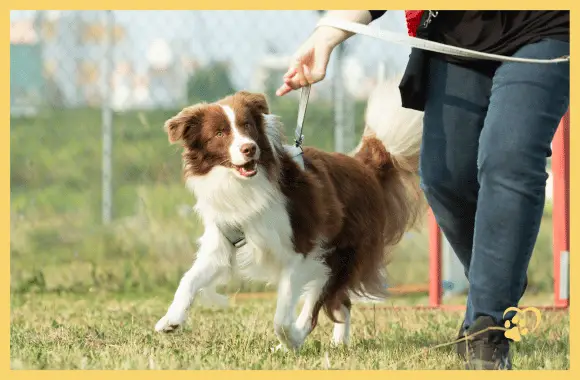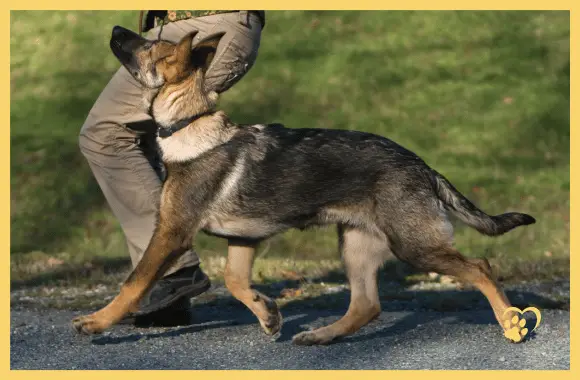Obedience, also called obedience training, is a dog sport that involves the dog performing a series of commands and exercises precisely and obediently, often under competition conditions.
Obedience, however, is not just another dog sport. It's about clear communication and teamwork with your dog. If you're looking for a way to deepen your relationship with your pet while having fun training, Obedience is for you. In this article, we'll show you the basics and what you need to know as a beginner.
The basics of obedience
Obedience is more than just command and obedience. It is a way to communicate, understand and connect. It's about building a relationship with your dog where both parties are paying attention and responding to each other.
Think of obedience like a dance partnership. Both partners need to know their steps, but it is the communication between them that makes the dance fluid and beautiful. Obedience is not about giving the dog commands, but learning to give clear instructions that the dog is happy to follow.
Another basic principle of obedience is consistency. This means always using the same commands and reactions so that your dog knows exactly what is expected of him. Finally, it's also about patience and understanding. Not every day will be perfect and that's okay. The important thing is that you and your dog learn and grow together.
The advantages of obedience
Deepen the bond with the four-legged friend
Every dog owner knows that a bond with their pet is something special. With obedience you can deepen this relationship even more. It's not just about giving your dog commands, but also about working together as a team. You'll find that training together and being considerate of each other creates an even stronger bond of trust.
Physical and mental fitness for your dog
A dog that is exercised is a happy dog. Obedience not only trains the body, but also challenges your dog's mind. The various exercises and tasks ensure that your dog concentrates and playfully learns new skills. This keeps him fit and ensures a balanced everyday life.
Better communication and obedience
Maybe you know this: you call your dog and he pretends not to hear anything. With obedience training, such moments become rarer. You learn to give clear commands and your dog learns to respond to them. This not only improves obedience, but also general communication between you and your dog. And if you ever get into a situation where it matters, your dog will know what to do.

The basic commands: Sit, Down, Heel
Obedience means obedience - and this is where the basic commands come in. They are the foundation on which the entire training is built.
Let's start with the command Seat. Simply put, it means that your dog will sit when you tell him to. It sounds simple, but it's about more than just sitting. It's about how quickly and precisely your dog responds.
The command Place again teaches your dog to lie down as soon as you give the command. This is especially useful in situations where you want your dog to stay calm, for example in a restaurant or when visitors come.
Finally there are Foot. Here, your dog should walk directly at your side, with his shoulder area next to your knee. This ensures that he follows you closely and does not walk in front or behind you.
These basic commands are not only commands, but also a kind of communication between you and your dog. They form the basis for everything else in obedience and create a clear, understandable structure in everyday life.
Advanced commands in obedience
Retrieval
Retrieving is not just a simple "fetch the stick." In the obedience world, it's about much more. Here, the focus is on precision. Your dog learns to fetch a specific object on your command and bring it to you accurately and correctly. This is not just about bringing, but also about picking up and holding the object correctly.
Directions
Another advanced command is directional instructions. Imagine being able to show your dog exactly where to go, and he follows your directions to the letter. With directional commands, you train your dog to go exactly where you point - be it left, right, or straight ahead.
Distance control
Can you imagine giving your dog a command from a few meters away that he immediately obeys? That's exactly what distance control is. Your dog learns to respond to your commands even when you are not standing right next to him. This requires not only training, but also a high level of trust between you and your dog.
These advanced commands will take you and your dog to a new level in obedience training. They are not only a challenge for the dog, but also for you as the handler. But with patience and practice, you will master it together.
Box Send
One of the most fascinating commands in obedience is certainly the box send. This involves sending your dog to a marked area or "box", often by a simple hand signal or command.
This may sound simple at first glance, but the perfection of this exercise requires precision, understanding and a close connection from both the dog and you. The point is to make it clear to the dog where to go without saying a word. It is impressive for the spectators to see how a dog can react so precisely to a seemingly small sign.
The box send is not only a demonstration of obedience and training, but also a proof of the bond between you and your dog. It shows that you are a harmonious team and that each knows exactly the thoughts and intentions of the other.

Obedience equipment
What you really need in the beginning
You have decided to dive into the world of obedience with your dog? Congratulations! Getting started in this sport the right way is not only a matter of training, but also of equipment. Fortunately, you don't need much to get started. A good collar, a sturdy leash and, of course, a lot of patience and treats for your four-legged friend.
The best leashes, collars and more
For obedience, an adjustable leash is recommended to give you flexibility in training. Collars should fit comfortably but securely. Avoid collars that can strangle the dog. Some dog trainers swear by harnesses instead of collars because they distribute pressure more evenly. When choosing training aids such as retrievers, make sure they are safe and easy for your dog to use.
Safety first
Your safety and that of your dog is our top priority. Always make sure your training is done in a safe environment, free from hazards such as road traffic or other distractions. Leashes and collars should be checked regularly to make sure they don't break. And remember that positive reinforcement and patience are the best tools in your training arsenal.
A guide for the perfect start to obedience training
The ideal training ground
The first step is to find a suitable place. Look for a quiet place without distractions, ideally with some space. A fenced-in yard or a quiet park are often good places to start. Remember that your dog needs to feel comfortable in a new environment in order to focus on training.
Motivation and reward
One of the most important things to consider is how you motivate and reward your dog. Every dog is different; while some dogs love treats, others respond better to praise or toys. Experiment a little and find out what motivates your dog the most.
Positive feedback and patience are key to successful training.
Typical beginner mistakes in obedience
Too long training sessions
Your enthusiasm is admirable, but long training sessions can overwhelm your dog. Short, focused sessions are more effective and keep your dog motivated. Quality goes before quantity.
Unclear commands and signals
Your dog does not understand your language. That's why it's important to stay consistent with your commands. Don't keep switching between "sit" and "down." Choose one word or signal and stick with it.
Expecting results too quickly
Every dog has its own learning pace. If you move too quickly and introduce new commands before your dog understands the old ones, it can lead to confusion. Patience is the key.
Neglecting the basics
Even though it is tempting to start directly with more complex exercises, the basics are the foundation for successful training. "Sit", "Down" and "Foot" are the building blocks for advanced exercises.
Lack of consistency
Obedience requires consistency, both in the application of commands and in the rewards. If you only give your dog an occasional reward when he performs a command, he will be confused. Be consistent and your dog will learn faster and feel more confident.
Obedience clubs and trainings
Why clubs and trainings are so valuable
Have you ever wondered if an obedience club or special training is right for your dog? It's not just a way to meet like-minded people. Clubs and classes provide a structured environment where you and your dog can learn and grow.
- Guided Learning: Professional trainers know exactly how to teach dogs to follow commands effectively. They give clear instructions and helpful tips.
- Socialization: In the club or during training your dog meets other dogs. This promotes social skills and interaction with conspecifics.
- Access to Resources: Many clubs have specialized training equipment and methods that may not otherwise be available to you.
- Motivation: Regular training keeps you and your dog on your toes. Shared experiences of success strengthen the bond and promote motivation.
Find the right club or trainer
A good club or trainer can make all the difference when it comes to teaching your dog obedience. But how do you find the right one?
- Obtain recommendations: Ask other dog owners, veterinarians or local shelters for good addresses in your area.
- Research: Search the Internet for reviews and experiences of other dog owners.
- Trial lesson: Most clubs and trainers offer a free or discounted trial lesson. This way you can find out for yourself if the chemistry is right and the training style suits you and your dog.
- Check qualification: A good trainer has appropriate training and certificates. Do not be afraid to ask for them.
Remember that you and your dog are a team. The right club or trainer will help you get the best out of your dog.
Learn more about dog sports:
- Dog sports: How your dog and you can get fit together

- Puppy training in dog sports: step-by-step guide to healthy athletic development.

- Agility training: step by step guide for beginners

- Successful Dogdancing: The best tips for dance routines with different breeds of dogs.

In conclusion
Obedience is more than just commands and training. It is a journey where you and your dog grow together, build trust and experience beautiful moments.
The key to success is patience, perseverance and the right support. Whether you choose to join a club, take a course or study on your own, stay on the ball and enjoy every step of this exciting journey.
